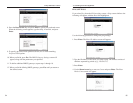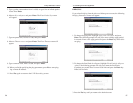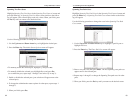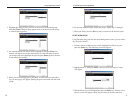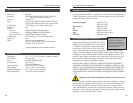
10/100 Managed 24-Port GigaSwitch
BRIDGE GROUPS SUPPORTED
The GigaSwitch supports the following four groups of Bridge MIB
(RFC1493):
• The dot1dBase Group a mandatory group that contains the objects appli-
cable to all types of bridges.
• The dot1dStp Group contains the objects that denote the bridge's state,
with respect to the Spanning Tree Protocol. If a node does not implement
the Spanning Tree Protocol, this group will not be implemented. This group
is applicable to any transparent only, source route, or SRT bridge that imple-
ments the Spanning Tree Protocol.
• The dot1dTp Group contains objects that describe the entity's transparent
bridging status. This group is applicable to transparent operation only and
SRT bridges.
• The dot1dStatic Group contains objects that describe the entity's destina-
tion-address filtering status. This group is applicable to any type of bridge
which performs destination-address filtering.
77
Linksys EtherFast
®
II Series
• Warm start
• Cold start
• Link up
• Link down
• Authentication failure
• Rising alarm
• Falling alarm
• Topology change
MIB-2 defines a set of manageable objects in various layers of the TCP/IP
protocol suites. MIB-2 covers all manageable objects from layer 1 to layer 4
and, as a result, is the major SNMP MIB supported by all vendors in the net-
working industry. The GigaSwitch supports a complete implementation of
SNMP Agent and MIB-2.
RMON MIB (RFC 1757) and Bridge MIB (RFC 1493)
The GigaSwitch provides hardware-based RMON counters in the switch
chipset. The switch manager CPU polls these counters periodically to collect
the statistics in a format that complies with the RMON MIB definition.
RMON GROUPS SUPPORTED
The GigaSwitch supports the following RMON MIB groups defined in
RFC1757:
• RMON Statistics Group maintains utilization and error statistics for the
switch port being monitored.
• RMON History Group gathers and stores periodic statistical samples from
the previous Statistics Group.
• RMON Alarm Group allows a network administrator to define alarm
thresholds for any MIB variable. An alarm can be associated with Low
Threshold, High Threshold, or both. A trigger can trigger an alarm when the
value of a specific MIB variable exceeds a threshold, falls below a thresh-
old, or exceeds or falls below a threshold.
• RMON Event Group allows a network administrator to define actions
based on alarms. SNMP Traps are generated when RMON Alarms are trig-
gered. The action taken in the Network Management Station depends on the
specific network management application.
76



